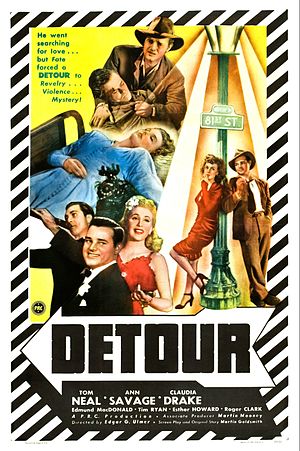Detour (1945 film)
| This article was copied (instead of imported) from the now-deleted Miraheze wikis. |
"This movie from Hollywood's poverty row, shot in six days, filled with technical errors and ham-handed narrative, starring a man who can only pout and a woman who can only sneer, should have faded from sight soon after it was released in 1945. And yet it lives on, haunting and creepy, an embodiment of the guilty soul of film noir. No one who has seen it has easily forgotten it."
— From Roger Ebert's Great Movies review
| Detour (1945 film) | ||||||||||||||||||||||||
|---|---|---|---|---|---|---|---|---|---|---|---|---|---|---|---|---|---|---|---|---|---|---|---|---|
This film has been preserved in the National Film Registry in 1992.
| ||||||||||||||||||||||||
 | ||||||||||||||||||||||||
|
Detour is a 1945 American film noir directed by Edgar G. Ulmer starring Tom Neal and Ann Savage. The screenplay was adapted by Martin Goldsmith and Martin Mooney (uncredited) from Goldsmith's 1939 novel of the same title, and released by the Producers Releasing Corporation, one of the so-called Poverty Row film studios in mid-20th-century Hollywood.
In 1992, Detour was selected for the United States National Film Registry by the Library of Congress as being "culturally, historically, or aesthetically significant".
Why It Rocks
- Even though the film is an extremely cheap melodrama shot in six days, it has still managed to develop cult status as one of the most stylish B pictures ever produced. The story's told in narration addressed directly to the audience who hears not what happened, but what Al wants us to believe happened. Its hackneyed dialog, quick-and-dirty camera work, and shabby no-budget rear projection combine to create a bleak nightmare existence. This proves that a movie doesn't have to be a high-budget blockbuster to be truly memorable.
- With the flashback structure and over-determined plot, it's one of most noteworthy film noirs of its time -- an example of un-American fatalism in an echt American world, populated by slangy, tough characters.
- As usual per Edgar G. Ulmer films, his stylistic conviction dignifies even the most atrocious script as authentic kindermärchen while raising absurdity to a form of primordial make–believe. All the production’s liabilities — back-projected locations, limited actors, six sets, abrupt ending, serve as formal tropes within the film. Every shot advances the story, every scene cements the hero's fate. And the dialogue's hard-bitten as well.
- Another noteworthy factor of the film is how it doesn't contain various elements most thrillers have such as a complicated plot, detectives, crooks and schemes. The film has a good girl, a bad girl, and a loser that are all trapped in a bitter nightmare that unfolds in an anonymous indifferent city, or equally anonymous road.
- Tom Neal and Ann Savage pull off great performances as their characters with Neal as a morally corrupt, but sympathetic petulant loser with haunted eyes and a weak mouth, and the appropriately-named Savage playing a femme fatale who “looked like she'd just been thrown off the crummiest freight train in the world.”
- It should also be noted that Neal's character Al Roberts is noticeably more innocent, and well-intentioned than the average film noir protagonist. Since Al Roberts was narrating the story this whole time, it's possible that Al may have been fabricating some of the details as a way to paint himself as more good-hearted than he truly is. The film intentionally leaves it ambiguous over whether or not Al's story was true or whether any of his crimes were intentional, which is part of what makes this film so timeless despite all of its downsides.
- Top-notched usage of lighting from Benjamin H. Kline: Shadows, dark corners, fog, and rain are standard in most film noirs and provide numerous opportunities to experiment with lighting, and this film features all of it. There's an iconic scene near the beginning, as Al Roberts is seen driving a convertible at night on a lonely stretch of road. To occupy his mind, Al fantasizes about his future, with his face dimly lit and reflected in the rearview mirror. The subject of his fantasy is performing in a sequined dress, a source of light in of itself. He rouses himself from his dream when it begins to rain, each drop lit from the car’s solid beam headlights. This single scene is a masterclass and illustrates the careful consideration that went into the film’s lighting strategy.
The Only Bad Quality
- As stated above, the movie was shot in six days, and it really shows as it's filled with technical errors and contains an overall ham-handed narrative. It seems as if even though the narrative script works out well enough, the continuity between scenes is all over the place, although for reasons mentioned above, this might have been intentional.